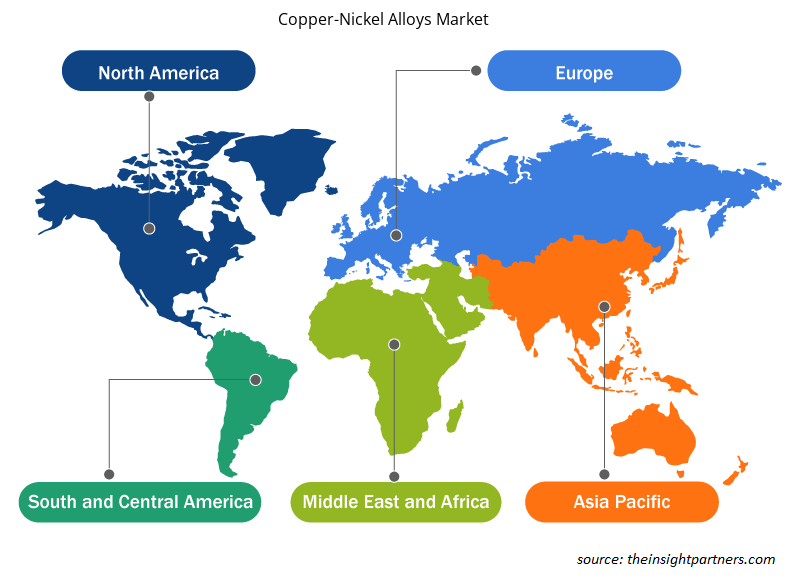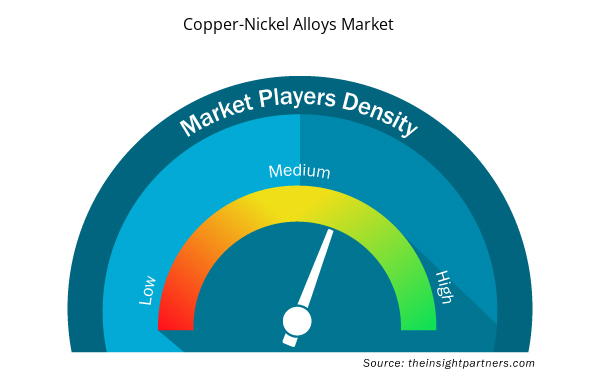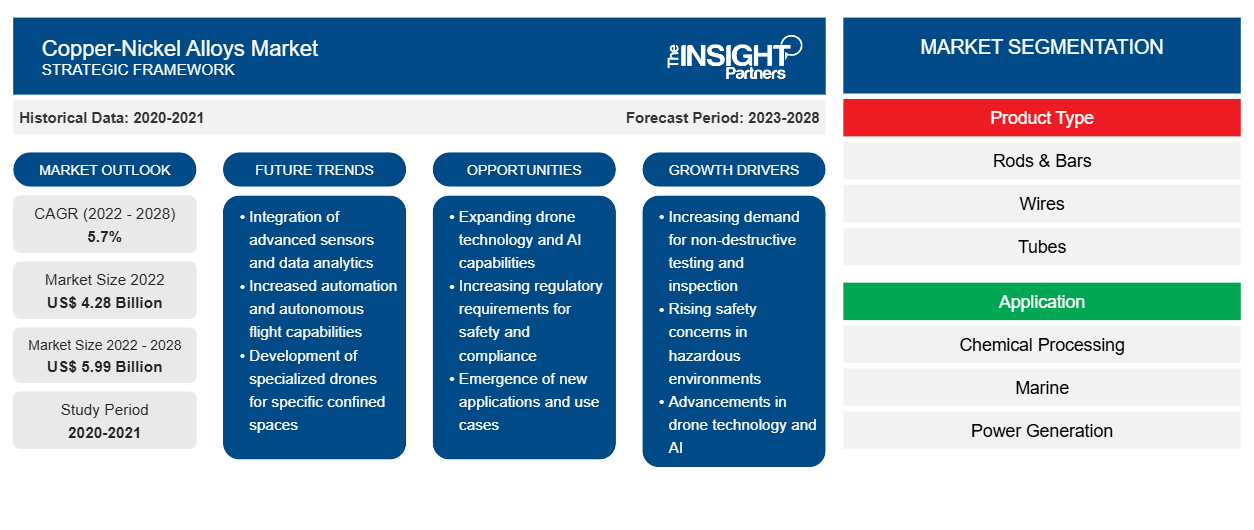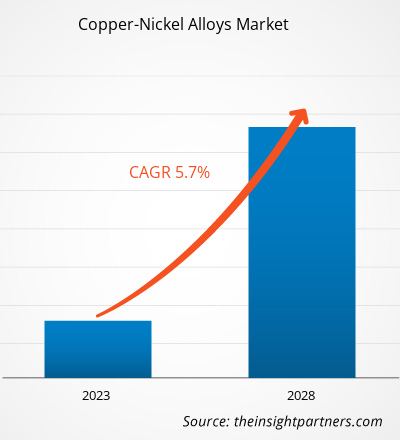Si stima che il mercato delle leghe di rame-nichel raggiungerà i 5.989,37 milioni di dollari entro il 2028; si prevede che crescerà a un tasso annuo di crescita composto ( CAGR ) del 5,7% dal 2022 al 2028.
Le leghe di rame-nichel hanno un'eccellente resistenza alla corrosione. Presentano anche resistenza al macrofouling grazie alla formazione di uno strato di ossido protettivo sulle loro superfici. Le leghe di rame-nichel sono solitamente disponibili in due varietà: Cu-Ni (90-10) e Cu-Ni (70-30). La lega Cu-Ni (70-30) è più forte e ha una maggiore resistenza alla corrosione (causata dall'acqua di mare) e al macrofouling rispetto a Cu-Ni (70-30). Tuttavia, Cu-Ni- (90-10) è più conveniente di Cu-Ni (70-30) e ha una migliore durata in molte applicazioni finali. Le leghe di rame-nichel stanno riscontrando una forte domanda nei settori marittimo, di lavorazione chimica, di produzione di energia e di petrolio e gas, che sta principalmente guidando la crescita del mercato delle leghe di rame-nichel .
Personalizza questo report in base alle tue esigenze
Riceverai la personalizzazione gratuita di qualsiasi report, comprese parti di questo report, o analisi a livello nazionale, pacchetto dati Excel, oltre a usufruire di grandi offerte e sconti per start-up e università
- Scopri le principali tendenze di mercato in questo rapporto.Questo campione GRATUITO includerà analisi di dati che spaziano dalle tendenze di mercato alle stime e alle previsioni.
Impatto della pandemia di COVID-19 sul mercato delle leghe di rame-nichel
Le restrizioni sociali e commerciali imposte dai governi all'inizio della pandemia di COVID-19 hanno portato a un crollo significativo delle catene di fornitura, comprese le operazioni di import-export, che hanno avuto un impatto sui prezzi delle materie prime e ostacolato le operazioni dell'industria cantieristica. Anche l'industria petrolifera e del gas ha subito impatti simili della pandemia, poiché nel 2020 si è verificato un calo senza precedenti della domanda di petrolio greggio, che ha comportato un calo significativo dei suoi prezzi. Secondo il Bureau of Labor Statistics, nel 2020 la domanda di petrolio è diminuita di 3 milioni di barili al giorno, il che rappresenta circa il 20% del consumo complessivo di petrolio degli Stati Uniti. Pertanto, il grave impatto della pandemia di COVID-19 sulle industrie marittime e petrolifere e del gas ha avuto un impatto negativo sulla domanda di leghe di rame-nichel. Inoltre, a causa della chiusura delle unità produttive, la produzione di leghe di rame-nichel è stata sospesa, il che ha ostacolato la redditività dei produttori su piccola e larga scala.
Nel 2021, i governi di vari paesi hanno annunciato allentamenti nelle restrizioni precedentemente imposte e hanno consentito ai produttori di operare a piena capacità. Di conseguenza, i produttori di leghe di rame-nichel hanno rivisto le loro strategie per aumentare la produzione, il che dovrebbe superare il deficit di produzione e il divario tra domanda e offerta. Si prevede che questo fattore stimolerà il mercato globale delle leghe di rame-nichel durante il periodo di previsione.
Approfondimenti di mercato
L'aumento dell'adozione di leghe di rame-nichel nei progetti di energia rinnovabile introduce nuove tendenze di crescita nel mercato delle leghe di rame-nichel
I governi di vari paesi stanno incoraggiando le persone a utilizzare fonti di energia rinnovabili per ridurre l'impatto ambientale complessivo. Turbine, pale, scambiatori di calore (nei sistemi CSP a energia solare concentrata), turbine eoliche e molti componenti utilizzati nella generazione di energia rinnovabile sono realizzati in leghe di rame-nichel. Secondo l'Agenzia internazionale per l'energia (IEA), l'uso di energia rinnovabile è aumentato del 3% a livello globale nel 2020. La quota di generazione di energia globale attraverso fonti di energia rinnovabile ha raggiunto il 29% nel 2020 dal 27% nel 2019. Gli Stati Uniti, l'Unione europea (UE), la Cina e l'India, tra gli altri paesi, stanno adottando varie iniziative per guidare gli investimenti nella produzione di energia pulita per la salvaguardia dell'ambiente e lo sviluppo economico sostenibile. Ad esempio, a marzo 2022, l'Unione europea ha ideato il "Piano REPowerEU" per produrre energia pulita e risparmiare energia per evitare la dipendenza dalle fonti di combustibili fossili russe. Il piano RePowerEU mira a raggiungere una produzione totale di energia rinnovabile di 1.236 Giga Watt entro il 2030. La Commissione europea ha dichiarato che l'implementazione del piano REPowerEU, nel periodo 2022-2027, richiederà un investimento aggiuntivo di 208,91 miliardi di dollari USA, che prevede di reperire dagli stati membri dell'UE e dal settore privato. Si prevede che tali iniziative governative in diversi paesi stimoleranno il settore delle energie rinnovabili in futuro, rafforzando a sua volta la crescita del mercato delle leghe di rame-nichel.
Informazioni sul tipo di prodotto
In base al tipo di prodotto, il mercato globale delle leghe di rame-nichel è stato segmentato in barre, fili, tubi e altri. Il segmento delle barre ha detenuto la quota di mercato più grande nel 2021. Le barre tonde di rame-nichel sono utilizzate in servosterzo, linee dei freni, tubi di distillazione, piastre del condensatore e recipienti a pressione grazie alle loro proprietà uniche come resistenza al macrofouling, buona resistenza alla trazione e resistenza alla corrosione. Inoltre, le barre di rame-nichel con il 10% e il 30% di nichel sono comunemente impiegate in condensatori, distillatori, evaporatori, tubi dello scambiatore di calore, valvole lavorate e forgiate e parti di pompe utilizzate per i servizi di acqua di mare.
Corrotherm International Ltd, Fisk Alloy Inc, Lebronze Alloys SAS, Materion Corp, Aesteiron Steels LLP, Columbia Metals Ltd, American Elements Inc, Hexion Steel Ltd, Aviva Metals Inc e Kalikund Steel and Engg Co sono tra i principali attori che operano nel mercato globale delle leghe di rame-nichel. Le aziende in questo mercato si concentrano costantemente su strategie quali investimenti in attività di ricerca e sviluppo e lancio di nuovi prodotti.
Approfondimenti regionali sul mercato delle leghe di rame-nichel
Le tendenze regionali e i fattori che influenzano il mercato delle leghe di rame-nichel durante il periodo di previsione sono stati ampiamente spiegati dagli analisti di Insight Partners. Questa sezione discute anche i segmenti e la geografia del mercato delle leghe di rame-nichel in Nord America, Europa, Asia Pacifico, Medio Oriente e Africa e America centrale e meridionale.

- Ottieni i dati specifici regionali per il mercato delle leghe di rame-nichel
Ambito del rapporto di mercato sulle leghe di rame-nichel
| Attributo del report | Dettagli |
|---|---|
| Dimensioni del mercato nel 2022 | 4,28 miliardi di dollari USA |
| Dimensioni del mercato entro il 2028 | 5,99 miliardi di dollari USA |
| CAGR globale (2022 - 2028) | 5,7% |
| Dati storici | 2020-2021 |
| Periodo di previsione | 2023-2028 |
| Segmenti coperti | Per tipo di prodotto
|
| Regioni e Paesi coperti | America del Nord
|
| Leader di mercato e profili aziendali chiave |
|
Densità degli attori del mercato delle leghe di rame-nichel: comprendere il suo impatto sulle dinamiche aziendali
Il mercato delle leghe di rame-nichel sta crescendo rapidamente, spinto dalla crescente domanda degli utenti finali dovuta a fattori quali l'evoluzione delle preferenze dei consumatori, i progressi tecnologici e una maggiore consapevolezza dei vantaggi del prodotto. Con l'aumento della domanda, le aziende stanno ampliando le loro offerte, innovando per soddisfare le esigenze dei consumatori e capitalizzando sulle tendenze emergenti, il che alimenta ulteriormente la crescita del mercato.
La densità degli operatori di mercato si riferisce alla distribuzione di aziende o società che operano in un particolare mercato o settore. Indica quanti concorrenti (operatori di mercato) sono presenti in un dato spazio di mercato in relazione alle sue dimensioni o al valore di mercato totale.
Le principali aziende che operano nel mercato delle leghe di rame-nichel sono:
- Azienda
- Società di produzione Fisk Alloy Inc.
- Leghe Lebronze SAS
- Società Materion.
- Acciai Aesteiron LLP
Disclaimer : le aziende elencate sopra non sono classificate secondo un ordine particolare.

- Ottieni una panoramica dei principali attori del mercato delle leghe di rame-nichel
Segnala i riflettori
- Tendenze industriali progressive nel mercato delle leghe di rame-nichel per aiutare gli operatori a sviluppare strategie efficaci a lungo termine
- Strategie di crescita aziendale adottate dalle aziende per proliferare nei mercati sviluppati e in via di sviluppo
- Analisi quantitativa del mercato delle leghe rame-nichel dal 2020 al 2028
- Stima della domanda globale di leghe di rame-nichel
- Analisi delle cinque forze di Porter per illustrare l'efficacia di acquirenti e fornitori nel settore
- Sviluppi recenti per comprendere lo scenario competitivo del mercato
- Tendenze e prospettive di mercato, fattori trainanti e limitanti nel mercato delle leghe di rame-nichel
- Assistenza nel processo decisionale evidenziando le strategie di mercato che sostengono l'interesse commerciale
- Dimensioni del mercato delle leghe di rame-nichel in vari nodi
- Panoramica dettagliata e segmentazione del mercato, nonché dinamiche del settore delle leghe di rame-nichel
- Dimensioni del mercato delle leghe di rame-nichel in varie regioni con promettenti opportunità di crescita
Profili aziendali
- Corrotherm International Ltd
- Lega Fisk Inc.
- Leghe Lebronze SAS
- Corporazione Materion
- Acciai Aesteiron LLP
- Columbia Metals Ltd
- Elementi americani Inc.
- Acciaio Hexion Ltd
- Aviva Metals Inc
- Kalikund Steel e Engg Co.
- Analisi storica (2 anni), anno base, previsione (7 anni) con CAGR
- Analisi PEST e SWOT
- Valore/volume delle dimensioni del mercato - Globale, regionale, nazionale
- Industria e panorama competitivo
- Set di dati Excel


- Predictive Maintenance Market
- Hot Melt Adhesives Market
- Integrated Platform Management System Market
- Artificial Intelligence in Defense Market
- Quantitative Structure-Activity Relationship (QSAR) Market
- Sandwich Panel Market
- Online Exam Proctoring Market
- Railway Braking System Market
- Procedure Trays Market
- 3D Mapping and Modelling Market

Report Coverage
Revenue forecast, Company Analysis, Industry landscape, Growth factors, and Trends

Segment Covered
This text is related
to segments covered.

Regional Scope
North America, Europe, Asia Pacific, Middle East & Africa, South & Central America

Country Scope
This text is related
to country scope.
Domande frequenti
Based on the application, marine segment is projected to register the highest CAGR over the forecast period. In recent years, the use of copper-nickel tubes has been extended to hydraulic and instrumentation systems, which have become increasingly important in the operations of ship and offshore platform control and monitoring systems. The copper-nickel alloys offer excellent resistance to saltwater corrosion, ensuring a highly reliable system.
Widespread applications of copper-nickel alloys is driving the copper-nickel alloys market growth. Copper-nickel alloys are used in various industries, including shipbuilding, oil & gas, aerospace, automotive, paper & pulp, and food & beverages. In the marine industry, the alloys are used to fabricate components and pipe fittings for ships and seagoing vessels. As copper-nickel alloys withstand high corrosion rates, they are extensively used as sheathing on oil and gas platforms. Moreover, the alloys are used in floating production storage and offloading (FPSO) vessels in the offshore oil & gas industry.
Asia Pacific accounted for the largest share of the global copper-nickel alloys market. The continued economic growth and urbanization of the region require developing reliable and affordable energy systems with significant additional electricity-generating capacity. According to the International Energy Agency, the installed electricity-generating capacity of the region is expected to rise by approximately 7% per annum, from 3,386 GW in 2019 to 6,113 GW by 2030. In addition, the amount of investment in renewable energy production across the region is expected to reach US$ 1.3 trillion per annum by 2030.
Based on product type, rods & bars segments mainly have the largest revenue share. Copper-nickel bars are an alloy of copper, nickel, and other strengthening elements such as manganese and iron. Copper-nickel round bars are used in power steering, brake lines, distiller tubes, condenser plates, and pressure vessels. Owing to their unique properties such as resistance to macro fouling, good tensile strength, and corrosion resistance, the round bars are specified for shipbuilding and repair, desalination plants, offshore oil and gas structures, power generation, and other marine engineering applications. Further, copper-nickel rods with 10% and 30% nickel are commonly employed for condensers, distillers, evaporators, heat exchanger tubes, machined and forged valves, and pump parts used for seawater services. The rods are highly corrosion-resistant to salt water, which is helpful for heat exchangers and condensers in seawater systems.
The major players operating in the global copper-nickel alloys market are Corrotherm International Ltd.; Fisk Alloy Inc.; Lebronze Alloys SAS; Materion Corp.; Aesteiron Steels LLP; Columbia Metals Ltd.; American Elements Inc.; Hexican Steel Ltd.; Aviva Metals Inc.; Kalikund Steel and Engg. Co.
Presence of large-desalination plants in the Middle East and Africa is anticipated to offer lucrative growth opportunities for the copper-nickel alloys market. Copper-nickel alloys have excellent corrosion resistance. Copper-nickel alloys are widely used in multi-stage flash distillation (MSF) and multiple-effect distillation (MED) desalination plants to provide high corrosion resistance to heat exchangers and other components, including tubeplate, water boxes, pipe fittings, and evaporator shells. When seawater is fed to the desalination system, it causes corrosion of metal components, which can reduce the lifespan of the total system. Therefore, copper-nickel alloys are used in desalination systems. Thus, the presence of a large number of desalination plants in the Middle East & Africa is expected to create huge demand for copper-nickel alloys, which would provide lucrative opportunities for the market during the forecast period.
Trends and growth analysis reports related to Chemicals and Materials : READ MORE..
The List of Companies - Copper-Nickel Alloys Market
- Corrotherm International Ltd.
- Fisk Alloy Inc.
- Lebronze Alloys SAS
- Materion Corp.
- Aesteiron Steels LLP
- Columbia Metals Ltd.
- American Elements Inc.
- Hexican Steel Ltd.
- Aviva Metals Inc.
- Kalikund Steel and Engg Co.
The Insight Partners performs research in 4 major stages: Data Collection & Secondary Research, Primary Research, Data Analysis and Data Triangulation & Final Review.
- Data Collection and Secondary Research:
As a market research and consulting firm operating from a decade, we have published and advised several client across the globe. First step for any study will start with an assessment of currently available data and insights from existing reports. Further, historical and current market information is collected from Investor Presentations, Annual Reports, SEC Filings, etc., and other information related to company’s performance and market positioning are gathered from Paid Databases (Factiva, Hoovers, and Reuters) and various other publications available in public domain.
Several associations trade associates, technical forums, institutes, societies and organization are accessed to gain technical as well as market related insights through their publications such as research papers, blogs and press releases related to the studies are referred to get cues about the market. Further, white papers, journals, magazines, and other news articles published in last 3 years are scrutinized and analyzed to understand the current market trends.
- Primary Research:
The primarily interview analysis comprise of data obtained from industry participants interview and answers to survey questions gathered by in-house primary team.
For primary research, interviews are conducted with industry experts/CEOs/Marketing Managers/VPs/Subject Matter Experts from both demand and supply side to get a 360-degree view of the market. The primary team conducts several interviews based on the complexity of the markets to understand the various market trends and dynamics which makes research more credible and precise.
A typical research interview fulfils the following functions:
- Provides first-hand information on the market size, market trends, growth trends, competitive landscape, and outlook
- Validates and strengthens in-house secondary research findings
- Develops the analysis team’s expertise and market understanding
Primary research involves email interactions and telephone interviews for each market, category, segment, and sub-segment across geographies. The participants who typically take part in such a process include, but are not limited to:
- Industry participants: VPs, business development managers, market intelligence managers and national sales managers
- Outside experts: Valuation experts, research analysts and key opinion leaders specializing in the electronics and semiconductor industry.
Below is the breakup of our primary respondents by company, designation, and region:

Once we receive the confirmation from primary research sources or primary respondents, we finalize the base year market estimation and forecast the data as per the macroeconomic and microeconomic factors assessed during data collection.
- Data Analysis:
Once data is validated through both secondary as well as primary respondents, we finalize the market estimations by hypothesis formulation and factor analysis at regional and country level.
- Macro-Economic Factor Analysis:
We analyse macroeconomic indicators such the gross domestic product (GDP), increase in the demand for goods and services across industries, technological advancement, regional economic growth, governmental policies, the influence of COVID-19, PEST analysis, and other aspects. This analysis aids in setting benchmarks for various nations/regions and approximating market splits. Additionally, the general trend of the aforementioned components aid in determining the market's development possibilities.
- Country Level Data:
Various factors that are especially aligned to the country are taken into account to determine the market size for a certain area and country, including the presence of vendors, such as headquarters and offices, the country's GDP, demand patterns, and industry growth. To comprehend the market dynamics for the nation, a number of growth variables, inhibitors, application areas, and current market trends are researched. The aforementioned elements aid in determining the country's overall market's growth potential.
- Company Profile:
The “Table of Contents” is formulated by listing and analyzing more than 25 - 30 companies operating in the market ecosystem across geographies. However, we profile only 10 companies as a standard practice in our syndicate reports. These 10 companies comprise leading, emerging, and regional players. Nonetheless, our analysis is not restricted to the 10 listed companies, we also analyze other companies present in the market to develop a holistic view and understand the prevailing trends. The “Company Profiles” section in the report covers key facts, business description, products & services, financial information, SWOT analysis, and key developments. The financial information presented is extracted from the annual reports and official documents of the publicly listed companies. Upon collecting the information for the sections of respective companies, we verify them via various primary sources and then compile the data in respective company profiles. The company level information helps us in deriving the base number as well as in forecasting the market size.
- Developing Base Number:
Aggregation of sales statistics (2020-2022) and macro-economic factor, and other secondary and primary research insights are utilized to arrive at base number and related market shares for 2022. The data gaps are identified in this step and relevant market data is analyzed, collected from paid primary interviews or databases. On finalizing the base year market size, forecasts are developed on the basis of macro-economic, industry and market growth factors and company level analysis.
- Data Triangulation and Final Review:
The market findings and base year market size calculations are validated from supply as well as demand side. Demand side validations are based on macro-economic factor analysis and benchmarks for respective regions and countries. In case of supply side validations, revenues of major companies are estimated (in case not available) based on industry benchmark, approximate number of employees, product portfolio, and primary interviews revenues are gathered. Further revenue from target product/service segment is assessed to avoid overshooting of market statistics. In case of heavy deviations between supply and demand side values, all thes steps are repeated to achieve synchronization.
We follow an iterative model, wherein we share our research findings with Subject Matter Experts (SME’s) and Key Opinion Leaders (KOLs) until consensus view of the market is not formulated – this model negates any drastic deviation in the opinions of experts. Only validated and universally acceptable research findings are quoted in our reports.
We have important check points that we use to validate our research findings – which we call – data triangulation, where we validate the information, we generate from secondary sources with primary interviews and then we re-validate with our internal data bases and Subject matter experts. This comprehensive model enables us to deliver high quality, reliable data in shortest possible time.


 Ottieni un campione gratuito per questo repot
Ottieni un campione gratuito per questo repot